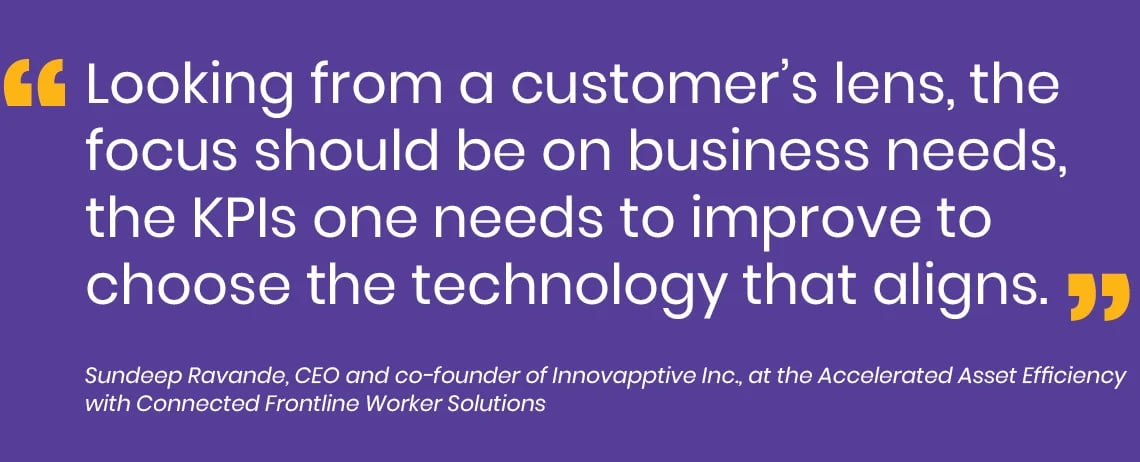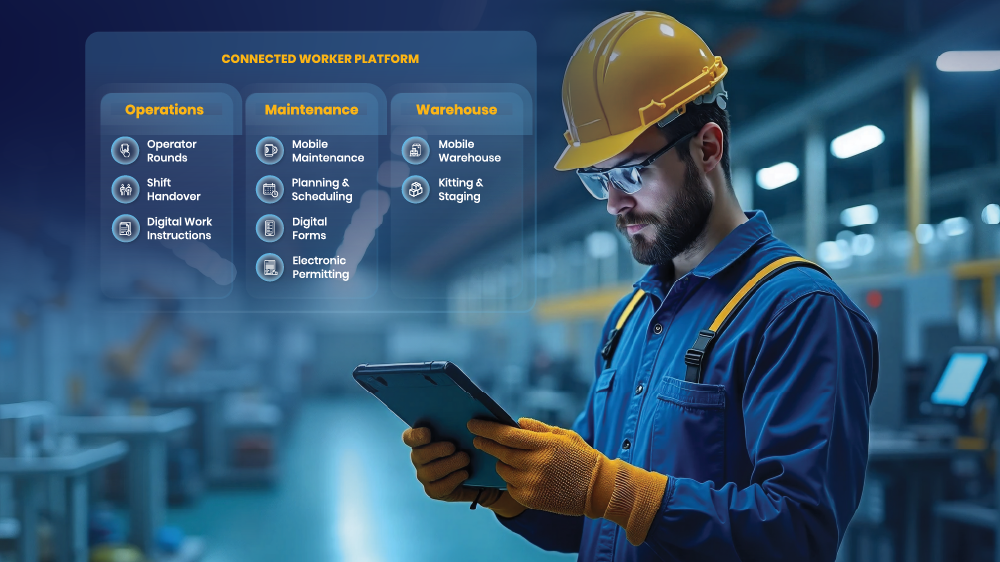Webinar Highlights Important Factors for Selecting the Right Connected Worker Solution

Digital transformation technology has revolutionized industrial plants and manufacturing facilities, particularly in the maintenance department and the spare parts warehouse. Versatile mobile apps empower frontline workers to perform their jobs faster, better, safer, and cheaper. Given the breadth of market offerings, organizations have a tough time selecting the right connected worker solution that best aligns with their business needs.
Evaluating a solution isn't easy, particularly for maintenance in asset-intensive industries where digital technologies take a back seat. Several factors come into play in the decision-making process.
In a recently concluded webinar, hosted by ReliabilityWeb, Innovapptive leaders discussed the focus areas and critical factors when choosing a connected worker platform.
Here's a snippet of the webinar discussion that pivoted around problems with disintegrated systems, the need for a truly connected solution, and key considerations to keep in mind while selecting a platform.
Problems Using Digital Technologies that Aren't Integrated
Most organizations lack sufficient integration with maintenance and external supply chain business practices. The lack of a unified connected worker solution magnifies maintenance wrench time problems. Technicians spend more time on non-productive tasks rather than on repairs.
Using multiple systems that can't integrate only means that there's no single source of data from which to draw insights and make knowledgeable decisions. Instead, managers are left with systems and data that often conflict and confuse, or create silos that hinder communication, collaboration, and productivity.
ERPs, EAMs, and third-party vendors don't offer the capability to tie separate mobile apps together in a single, unified platform. Some asset-intensive companies have developed in-house dashboards that try to unify different mobile apps in a single solution.
Unfortunately, these in-house dashboards deliver less than desirable results and reliability.
To overcome this, asset-intensive industries need a single platform that caters to the needs of all personnel and departments involved in maintenance and spare parts warehouse activities. All they need is a true connected worker solution.
What Is a True Connected Worker Solution?
A true connected worker solution provides a single, unified source of accurate, real-time data that delivers end-to-end visibility enterprise-wide, across departments and processes.
Integrated mobile apps empower frontline workers within their functional area and enable cooperation and communication with other groups. Desktop control centers allow supervisors and managers to better direct frontline workers and see a larger swath of data from across the enterprise, not just their departments, delivering total visibility and enabling better analysis, interpretation, and decision-making.
Everything is integrated seamlessly with the back-office ERP or EAM, removing silos and work management gaps caused by incompatible apps or systems. Everyone throughout the organization gets access to and works from a single source of information simultaneously. A true connected worker platform ties maintenance and the warehouse together.
Recommendations for Selecting a Connected Worker Platform
Connected worker platforms aim to improve the efficiency, productivity, and lives of frontline workers. They're geared towards organizational asset management, plant maintenance, and warehouse management.
The market is flooded with solutions claiming superior technologies and features available in different price ranges but the right decision pivots around choosing the solution that fulfills the industry and specific business needs. Overlooking IT's unique needs and concerns could jeopardize the initiative by draining resources, and wasting time and effort.
Here are factors to consider before making the final decision:
Rapid deployment – Faster time to market is imperative for companies recovering from a severe financial shock. Deployment of mobile-connected worker solutions for an ERP system usually takes several months. Do the math - how much would you need to pay for software developers for a month's delay in deployment?
Decrease downtime – Mobile solutions should communicate information between your company's ERP systems and frontline touchpoints. There's no point in buying a solution that doesn't integrate completely with your existing systems.
Easy maintenance – The scale of the mobile solutions decides the size of maintenance teams and budget allocations. Companies should carefully consider the ongoing maintenance needs of the mobile solutions they're going to buy.
Mobile user experience – Just because it's a "mobile" solution, don't assume this is just like any other app downloaded from the app store - that there's no training required to use it. A connected worker solution integrates with large ERP systems. If the platform features complex workflows, your not-so-techie frontline workers might stay away from using it.
Enterprise-grade security – Asset information is critical for your company. The security of the mobile solutions you use to maintain these assets is of paramount importance.
Connectivity – Maybe your frontline worker is in the middle of the Pacific Ocean or driving across the Sahara. What good is a mobile solution if you can't use it at poorly connected remote facilities? Establishing strong Wi-Fi networks in inaccessible, remote locations isn't a viable option considering the effort, investment, and ROI calculations.
Agility – Workflows and regulations are subject to change in industries. The problem with most mobile solutions is they need fundamental changes to enable users to access updated workflows and stay regulatory compliant. Pressed for time, your IT teams become overstretched. This reduces their efficiency and may lead to business failures.
Native mobile capabilities – Smartphones and ruggedized mobile devices these days are sophisticated. A best-in-class mobile solution should use every mobile capability to optimize processes and achieve a high degree of accuracy and efficiency.
Virtual assistance – A best-in-class connected worker solution should offer virtual, voice assistance to enable hands-free operations.
Total cost of ownership (TCO) – Unlike tangible assets, measuring the total cost of ownership for software products, is tricky but important in determining ROI.
Click here to view a free webinar recording.
Have Questions? Looking for Guidance? We're Here to Help
Innovapptive, a connected worker solution pioneer, specializes in SAP- and IBM Maximo-compatible mobile plant maintenance systems that improve productivity, transform reactive processes, and cut downtime costs. We have helped several global industry giants jump from disconnected processes with poor visibility and collaboration to more efficient and productive connected worker platforms. Click here to view our video or here to register for a free demo of our solutions.

See It In Action
Schedule a personalized demo to see how our solutions can help your business thrive.
- 29-09-2025
Your Ultimate Guide to Connected Worker
In the rapidly evolving industrial landscape, maximizing plant efficiency and ensuring optimal...
- 20-08-2025
Building the future of Industrial Operations with Innovapptive and AWS
Most manufacturers have already gone digital. Yet business outcomes haven’t moved in step. Many...
- 22-04-2025
The $3.6B Unlock: Solving the Chemical Industry’s Labor Crisis and EBITDA Pressure in One Move
“Constraints don’t slow innovation—they force it.”



